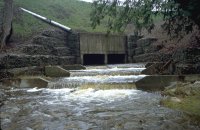The International Pacific Salmon Fisheries Commission formed in 1937 and included representatives from Canada and the United States. The goal of the Commission is to restore salmon bearing streams that have been blocked.
Dams and other obstructions cause waterways to change direction often causing floods and droughts. Migrating salmon can lose their way back to spawning grounds and may not survive to complete their life cycles.
One of the concerns of the IPSFC in the early 1940's were the sockeye runs in the Fraser and attached Adams Rivers. In 1913, the Canadian Northern Pacific Railway was building along a side of the canyon. A rock wall above Hell's Gate was either dynamited or bored away and the unused rock found its way down the bank and into the river.
The Commission was involved in the installation of special fishways in 1945 and 1946. A logging dam was also removed and in 1950, the IPSFC made an artificial planting of sockeye eggs in the Upper Adams Lake.
The rehabilitation efforts have shown great success and runs of sockeye are coming back.

More recently, the needs of salmon are being considered when many dams are being built. (Wahleach) Jones Creek was dammed for power by B.C. Electric.
An example of an artificial spawning channel.
 |
An artificial spawning stream was put in place to redirect the salmon into a channel which runs almost beside the Creek and at one point rejoins the it. It is about twenty feet wide and one or two feet deep. The salmon swim down shallow steps which form pools of water that have good spawning gravel on the bottoms.
In spite of these improvements, conservationist and consultant of the IPSFC, Roderick L. Haig-Brown believed that, "even greater returns were possible in the future and further restoration of the runs is by no means impossible."
The International Pacific Salmon Fisheries Commission's patient work to repair the damage caused in the past through dams being built on salmon waterways would have to continue.
In Campbell River, British Columbia, The Haig-Brown Kingfisher Creek Society was formed to continue Haig-Brown's goal of restoring Haig-Brown Kingfisher Creek which provides habitat for coho salmon on a small stream flowing into the Campbell River.
Top of page.

